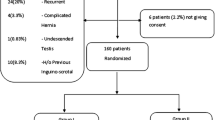Abstract
Background
Postoperative sexual dysfunction in relation to laparoscopic groin hernia surgery may be related to methods of mesh fixation. However, this has not been investigated earlier. Moreover, results regarding sexual dysfunction in females have not been reported systematically. The aim of this study was to compare fibrin sealant versus tacks for fixation of mesh regarding sexual dysfunction in males and females.
Methods
Using the Danish Hernia Database, patients operated laparoscopically for groin hernia with a transabdominal preperitoneal (TAPP) procedure with fibrin sealant or tacks for mesh fixation were sent a questionnaire regarding sexual dysfunction. Sexually active patients without recurrence were evaluated in this study.
Results
Pain during sexual activity was present in 115 of 1019 (11.3 %) males and 17 of 147 (11.6 %) females. There was no difference between fibrin sealant and tacks for mesh fixation and no difference between genders. Pain intensity, characteristics and origin were comparable between fibrin sealant and tacks for both genders. We found a relationship between a higher rate of sexual dysfunction and lower age for both genders.
Conclusion
We found no difference between fibrin sealant and tacks in pain during sexual activity or intensity of pain. However, younger age may be a risk factor for pain during sexual activity. Considering the high rate of postoperative sexual dysfunction, it is important to include this topic in the preoperative patient information.

Similar content being viewed by others
References
Eklund A, Montgomery A, Bergkvist L, Rudberg C, Swedish Multicentre Trial of Inguinal Hernia Repair by Laparoscopy study G (2010) Chronic pain 5 years after randomized comparison of laparoscopic and Lichtenstein inguinal hernia repair. Br J Surg 97:600–608
Aasvang EK, Mohl B, Bay-Nielsen M, Kehlet H (2006) Pain related sexual dysfunction after inguinal herniorrhaphy. Pain 122:258–263
Tolver MA, Rosenberg J (2015) Pain during sexual activity before and after laparoscopic inguinal hernia repair. Surg Endosc 29:3722–3725
Bischoff JM, Linderoth G, Aasvang EK, Werner MU, Kehlet H (2012) Dysejaculation after laparoscopic inguinal herniorrhaphy: a nationwide questionnaire study. Surg Endosc 26:979–983
Bendavid R (1992) “Dysejaculation”: an unusual complication of inguinal herniorrhaphy. Postgrad Gen Surg 4:139–141
Aasvang EK, Mohl B, Kehlet H (2007) Ejaculatory pain: a specific postherniotomy pain syndrome? Anesthesiology 107:298–304
Shah NS, Fullwood C, Siriwardena AK, Sheen AJ (2014) Mesh fixation at laparoscopic inguinal hernia repair: a meta-analysis comparing tissue glue and tack fixation. World J Surg 38:2558–2570
Li J, Ji Z, Zhang W (2015) Staple fixation against adhesive fixation in laparoscopic inguinal hernia repair: a meta-analysis of randomized controlled trials. Surg Laparosc Endosc Percutan Tech 25:471–477
Bittner R, Gmahle E, Gmahle B, Schwarz J, Aasvang E, Kehlet H (2010) Lightweight mesh and noninvasive fixation: an effective concept for prevention of chronic pain with laparoscopic hernia repair (TAPP). Surg Endosc 24:2958–2964
Bay-Nielsen M, Kehlet H, Strand L, Malmstrom J, Andersen FH, Wara P, Juul P, Callesen T, Danish Hernia Database C (2001) Quality assessment of 26,304 herniorrhaphies in Denmark: a prospective nationwide study. Lancet 358:1124–1128
Fenger AQ, Helvind NM, Pommergaard HC, Burcharth J, Rosenberg J (2016) Fibrin sealant for mesh fixation in laparoscopic groin hernia repair does not increase long-term recurrence. Surg Endosc 30:986–992
Lau H (2005) Fibrin sealant versus mechanical stapling for mesh fixation during endoscopic extraperitoneal inguinal hernioplasty: a randomized prospective trial. Ann Surg 242:670–675
Topart P, Vandenbroucke F, Lozac’h P (2005) Tisseel versus tack staples as mesh fixation in totally extraperitoneal laparoscopic repair of groin hernias: a retrospective analysis. Surg Endosc 19:724–727
Schouten N, van Dalen T, Smakman N, Clevers GJ, Davids PH, Verleisdonk EJ, Tekatli H, Burgmans JP (2012) Impairment of sexual activity before and after endoscopic totally extraperitoneal (TEP) hernia repair. Surg Endosc 26:230–234
Wei FX, Zhang YC, Han W, Zhang YL, Shao Y, Ni R (2015) Transabdominal preperitoneal (TAPP) versus totally extraperitoneal (TEP) for laparoscopic hernia repair: a meta-analysis. Surg Laparosc Endosc Percutan Tech 25:375–383
Zieren J, Menenakos C, Paul M, Muller JM (2005) Sexual function before and after mesh repair of inguinal hernia. Int J Urol 12:35–38
Sajid MS, Leaver C, Baig MK, Sains P (2012) Systematic review and meta-analysis of the use of lightweight versus heavyweight mesh in open inguinal hernia repair. Br J Surg 99:29–37
Bendavid R, Lou W, Grischkan D, Koch A, Petersen K, Morrison J, Iakovlev V (2015) A mechanism of mesh-related post-herniorrhaphy neuralgia. Hernia, 23 Nov 2015 [Epub ahead of print]
Chung L, Norrie J, O’Dwyer PJ (2011) Long-term follow-up of patients with a painless inguinal hernia from a randomized clinical trial. Br J Surg 98:596–599
Author information
Authors and Affiliations
Corresponding author
Ethics declarations
Disclosures
Dr. Pommergaard, Dr. Burcharth and Dr. Fenger have no conflicts of interest or financial ties to report. Dr. Andresen received nonfinancial support from Bard Davol Inc. Prof. Rosenberg has received grants from Johnson & Johnson Inc., and Bard Davol Inc., and personal fees from Bard Davol Inc., and Merck & Co. Inc.
Rights and permissions
About this article
Cite this article
Pommergaard, H.C., Burcharth, J., Andresen, K. et al. No difference in sexual dysfunction after transabdominal preperitoneal (TAPP) approach for inguinal hernia with fibrin sealant or tacks for mesh fixation. Surg Endosc 31, 661–666 (2017). https://doi.org/10.1007/s00464-016-5017-4
Received:
Accepted:
Published:
Issue Date:
DOI: https://doi.org/10.1007/s00464-016-5017-4




